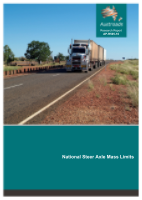Freight

- Publication no: AP-R505-16
- ISBN: 978-1-925294-94-1
- Published: 3 February 2016
- PDF (free) Download
This report examines issues associated with potential changes to mass limits for steer axles on heavy vehicles in Australia.
The project aimed to establish optimum steer axle mass limits, with a particular focus on suitability for road trains, to accommodate the needs of the transport industry into the future. The practical engineering issues associated with a heavier load on the steer axle and the fitments of wider tyres were investigated via industry consultation.
A pavement life cycle costing analysis was undertaken to determine the pavement maintenance costs associated with increased steer axle limits. The load wear cost model selected for this task was embodied in the Freight Axle Mass Limits Investigation Tool (FAMLIT) which was used to quantify the marginal differences in pavement deterioration. A selection of 25 road segments was used for analysis with 30 loading scenarios.
The study found that the optimum steer axle mass limit is 7.0 t, with a wider (greater than 375 mm) tyre size. This increase in steer axle limit can be applied to road train operators with minimal change in operations. The finding suggests that it is possible to increase the steer axle mass above 7.0 t before an increase in cost is realised, however an increase to 7.0 t allows a margin of safety for the limitations of the testing (variations in tyre construction and inflation pressure) on which the reference loads are based. An increase to 7.0 t will also be consistent with current limits in the Northern Territory.
- Summary
- 1. Introduction
- 1.1. Aim
- 1.2. Background
- 1.3. Project Scope
- 1.4. Current Legislation
- 1.4.1. Heavy Vehicle National Regulation
- 1.4.2. Northern Territory
- 1.4.3. Western Australia
- 1.4.4. Summary
- 2. Industry Needs
- 3. Industry Consultation
- 3.1. Consultation with Industry
- 3.1.1. Design Requirements
- 3.1.2. Freight Task Specific Requirements
- 3.1.3. Prime Mover Types
- 3.1.4. Heavy Vehicle Front Axle Capacity
- 3.2. Tyre Sizes
- 3.3. Practical Issues Related to Increased Steer Axle Loads
- 3.3.1. Horizontal Loading of Pavements
- 3.3.2. Over-width Vehicles Fitted with Wider Tyres
- 3.3.3. Component Fouling with Wider Tyres
- 3.3.4. Overloading Wheel Bearings
- 3.3.5. Summary of Practical Issues
- 4. Literature Review
- 4.1. Tyre and Pavement Interaction
- 4.2. Literature Review Summary
- 5. Pavement Life-Cycle Costing Analysis
- 5.1. Load Wear Cost Model Background
- 5.2. Analysis Methodology
- 5.3. Simulated Vehicle Fleet
- 5.3.1. Twin-steer Vehicles
- 5.3.2. Expected marginal savings for twin-steers
- 5.3.3. Traffic Counts and Vehicle Composition
- 5.4. Representation of the Heavy Vehicle Fleet used for Analysis
- 6. Road Data
- 6.2. Road Survey Data
- 6.1.1. Road Type
- 6.1.2. Condition
- 6.1.3. Maintenance
- 6.1.4. Traffic
- 6.1.5. Historical
- 6.1.6. Cost
- 7. Load Wear Cost Results
- 7.1. Overall Results
- 7.2. Application to Other Vehicles
- 7.2.1. Practical issues relating to the use of wider tyres on vehicles other than road trains
- 7.2.2. The suitability of the applying the load wear cost model to different pavement types
- 7.2.3. The industry’s need for increased steer axle mass
- 7.2.4. Consideration of costs and benefits related to freight efficiency and vehicle operations
- 8. Impact on Bridges
- 8.1. Bridge Formula
- 8.2. Elastic Analysis
- 9. Conclusions
- References
- Appendix A FAMLIT Analysis Results
- A.1 New South Wales
- A.1.1 Segment 1
- A.1.2 Segment 2
- A.1.3 Segment 3
- A.1.4 Segment 4
- A.1.5 Segment 5
- A.1.6 Segment 6
- A.2 Northern Territory
- A.2.1 Segment 1
- A.2.2 Segment 2
- A.2.3 Segment 3
- A.2.4 Segment 4
- A.2.5 Segment 5
- A.2.6 Segment 6
- A.3 Queensland
- A.3.1 Segment 1
- A.3.2 Segment 2
- A.3.3 Segment 3
- A.3.4 Segment 4
- A.4 Victoria
- A.4.1 Segment 1
- A.4.2 Segment 2
- A.4.3 Segment 3
- A.5 Western Australia
- A.5.1 Segment 1
- A.5.2 Segment 2
- A.5.3 Segment 3
- A.5.4 Segment 4
- A.5.5 Segment 5
- A.5.6 Segment 6
- Appendix B EAUC Estimation
